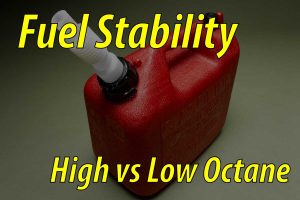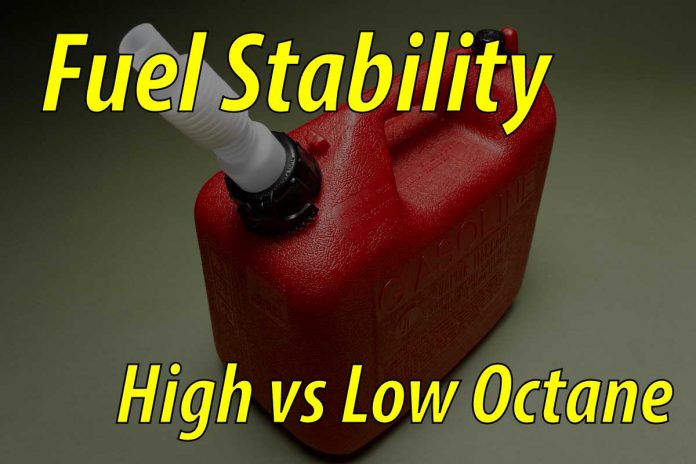High vs. Low Octane Fuel Stability
Does octane play a role in the shelf life of gasoline? Octane is the most discussed property when it comes to gas. It’s no shock because choosing the octane of gasoline is the single option the buyer has, besides what station or brand from which to purchase. In this article, we will concentrate on the stability of standard octane pump fuels (87 and 93) and what you can do to limit octane loss.
 It’s important to quickly review what octane is to dive deeper into fuel stability issues. At most gas stations throughout the US, octane ratings are typically presented as a number, 87 to 93. This number is the AKI (Anti-Knock Index). Manufacturers and regulatory bodies find the AKI of fuel by averaging its RON (Research Octane Number), and it’s MON (Motor Octane Number). These numbers present a scale to gauge how much pressure and heat the fuel can handle before spontaneous combustion. When a fuel spontaneously combusts it will cause pre-ignition, which is bad, or detonation, also known as “knock,” which is worse. Octane ratings are necessary because different engines expose fuel to various levels of heat and compression. Your engine needs the right octane level to avoid knock and operate reliably.
It’s important to quickly review what octane is to dive deeper into fuel stability issues. At most gas stations throughout the US, octane ratings are typically presented as a number, 87 to 93. This number is the AKI (Anti-Knock Index). Manufacturers and regulatory bodies find the AKI of fuel by averaging its RON (Research Octane Number), and it’s MON (Motor Octane Number). These numbers present a scale to gauge how much pressure and heat the fuel can handle before spontaneous combustion. When a fuel spontaneously combusts it will cause pre-ignition, which is bad, or detonation, also known as “knock,” which is worse. Octane ratings are necessary because different engines expose fuel to various levels of heat and compression. Your engine needs the right octane level to avoid knock and operate reliably.
How Does Octane Affect The Shelf Life Of Gasoline?
Vapor pressure is one of the significant aspects of fuel stability. Vapor pressure is measured by the amount of pressure that will build up in a sealed container when heated to 100°F (38°C). This pressure test will determine the number of hydrocarbons in the fuel that have a low boiling point. Pump fuel with high vapor pressure is typically used in cold weather to reduce starting issues at low temperatures. In this example, high would be around 12 psi. Depending on county and state, pump fuel vapor pressures are limited to a 7.8 to 9psi maximum in warm weather. Fuel will maintain its vapor pressure in an air-tight container, but fuel exposed to the atmosphere can lose it’s lighter components in a matter of days.
Given enough time and the vapor pressure of the fuel will decrease and turn “stale.” Stale fuel will not evaporate as quickly and will cause your engine to start hard and idle rough. The main fuel component used to adjust vapor pressure is butane, which is very combustible. Butane is very useful for maintaining octane levels when blending fuels to work in cold weather. The primary issue with using butane is that it boils above freezing when exposed to the atmosphere. This low boiling point means cold weather fuel is more susceptible to octane loss due to pressure loss than warm weather fuel.
Related: How does that sweet octane stay in your 2-stroke’s crankcase?
Shelf Life Of Ethanol Free Gasoline
Non-ethanol fuels with an octane rating of 87 are less refined with a higher amount of volatile hydrocarbons. When time passes while stored, the volatile ingredients degrade and form contaminates such as “varnish.” This degradation results in a decrease in octane value in a matter of months, even more so when stored improperly. Fuels with octane ratings of 91 or more are better refined and contain hydrocarbons that are much more stable than in 87 octane fuel. As a result of the further refinement and stable hydrocarbons, 93 octane fuel can last up to nine months when properly stored. Nine months is a significant increase from 87, which lasts about three months. Remember, all fuel will lose octane when blended with butane.
So, in conclusion, store your fuel in a vapor-tight container in a cool dark space!
If you have any questions or anything to add, please leave them in the comments or on our FaceBook page!





